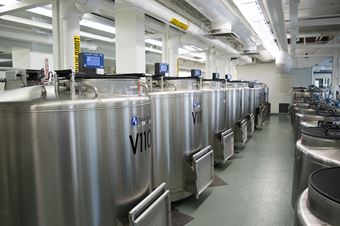 On the last day of February of each year, the world recognizes Rare Disease Day, an annual acknowledgment of the hundreds of millions of people around the world living with rare, genetic diseases. Many diseases fall into this category—about 10,000 such conditions are known today—and some affect just a small number of people, but being diagnosed with a genetic disease is anything but rare. In the United States, at least one in 10 people live with a condition that has a genetic origin.
On the last day of February of each year, the world recognizes Rare Disease Day, an annual acknowledgment of the hundreds of millions of people around the world living with rare, genetic diseases. Many diseases fall into this category—about 10,000 such conditions are known today—and some affect just a small number of people, but being diagnosed with a genetic disease is anything but rare. In the United States, at least one in 10 people live with a condition that has a genetic origin.
For those affected by a rare disease, there is an accessible way to contribute to the research effort. The Human Genetic Cell Repository (HGCR), sponsored by the National Institute of General Medical Sciences (NIGMS) and hosted at the Coriell Institute, contains many thousands of cell line and DNA samples derived from tissue donations from affected people, allowing researchers to study these diseases and develop new therapies. The collection of samples representing rare diseases is always growing!
If you or a family member are affected by a rare, heritable disease and would like to contribute, the NIGMS team at Coriell wants to hear from you. Please email NIGMS@Coriell.org.
For more information, see answers to frequently asked questions below.
Who is eligible to donate to the NIGMS HGCR?
Anyone who has been diagnosed with a rare, heritable disease and any members of that person’s family is welcome to contribute.
I'm interested in donating. What is needed from me?
Each tissue donation starts as either a bit of skin or blood—either is acceptable but must be acquired with the help of a professional—which is then packaged into a collection kit (provided by the NIGMS Repository at no cost) and shipped back to Coriell.
How do we get a blood draw or skin biopsy? What if insurance doesn't cover it?
Insurance typically will cover wellness or other clinical exams requiring blood work. Families or donors typically bring the kit to the blood collection appointment and ask the clinician to fill the tubes provided in the kit while taking blood as the doctor ordered. There is often no extra cost to this approach, but we can reimburse you up to $40 if there is.
Occasionally, clinic staff is unfamiliar with research-related collections, and it may help to call ahead (or have one of your doctors call for you) to ensure the person doing the blood draw is willing and able to fill the research tubes. Most donors have no trouble at all.
Some families may know someone who can collect blood for them at home, like a nurse. Other families successfully asked their pediatrician if they would kindly agree to draw blood at the practice.
Typically a skin sample is collected during another surgical procedure since we cannot reimburse for a skin biopsy. Otherwise, some families can arrange with the family doctor or dermatologist to collect the skin as a courtesy. Only a tiny sample (just a few millimeters in diameter) is needed.
How long do the biopsy kits last?
The biopsy medium is perishable and lasts for roughly a month if refrigerated. The expiration date is on the tube.
What happens then to the sample that I mailed to Coriell?
Our labs create a few different sample types from your donation. Blood samples are transformed into what are called lymphoblastoid cells (LCLs). These are immortalized cells—meaning we can continue to create more of them for a long time—that are useful in genetic studies.
Skin biopsy samples are transformed into a cell type known as fibroblasts. Fibroblasts are not immortalized, meaning we can only grow them so many times but they are helpful for functional studies that allow researchers to understand how a specific gene works.
The NIGMS HGCR also develops a new type of cell called induced pluripotent stem cells (iPSCs). These particular stem cells can be created from either skin or blood samples and can be coaxed into becoming nearly any type of cell in the body. For example, your skin punch can become fibroblasts, which can then be turned into iPSCs, which can then become heart or brain cells with your genetic information. These new stem cells are in demand from researchers for their versatility and utility in research.
Will I receive any genetic results related to my sample?
Unfortunately, the NIGMS Repository cannot return any information regarding the samples to the donors. Upon receipt, all samples are de-identified to maintain anonymity.
Can I still participate if I do not live in the US?
Yes! The NIGMS Repository collects samples from donors from all over the world. We will work with families to ensure that all customs documents are included in our international kits.
Should parents still donate a sample if the child's mutation is de novo?
Although the child's mutation is de novo, the parent's blood sample is also beneficial. Genetic testing can't rule out germline mutations, but future research may be able to detect things we have yet to be aware of. Also, parent samples can often be used as control samples.